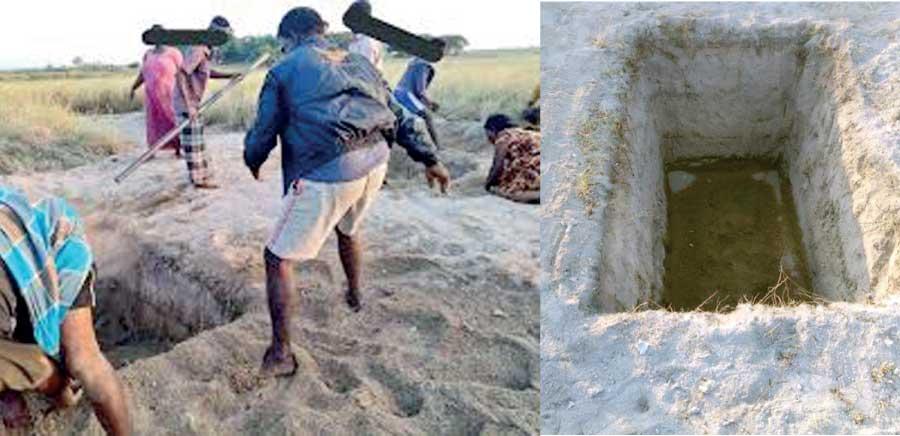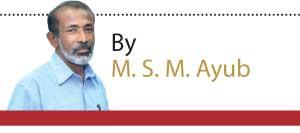Reply To:
Name - Reply Comment

When President Gotabaya Rajapaksa on November 10 instructed the officials to find a dry land to burry bodies of those who die of COVID-19, pro-government media and monks protested against burial of such bodies. It must also be noted that the President gave the instructions while the government was claiming that health officials had not given the green light to bury COVID-19 victims.
bodies of those who die of COVID-19, pro-government media and monks protested against burial of such bodies. It must also be noted that the President gave the instructions while the government was claiming that health officials had not given the green light to bury COVID-19 victims.
A month later, on December 10 - incidentally on the International Human Rights Day - Prime Minister Mahinda Rajapaksa also instructed the health officials to find a dry land for the same purpose. Accordingly, Water Supply Minister Vasudeva Nanayakkara said on December 27 that geologists of his ministry had found two areas – Eragama in Ampara District and Marichchikattu in Mannar District – where ground water cannot be found even at a depth of 30 feet even during the rainy season.
Then again the pro-government media in the guise of giving opportunity for all relevant views became a forum for the anti-burial groups. A group of leading monks walked in procession to the Presidential Secretariat in Galle Face to hand over a letter to the President condemning the government’s apparent decision to allow burial. However, there was no such decision then. When the Prime Minister told Parliament on February 10 that the government would allow burial again protests emerged even belittling him.
 Muslims in Sri Lanka have been agitating against the government’s policy of mandatory cremation of cadavers of those who die of COVID-19 since March 31 last year when the government decided not to allow burial for COVID-19 victims
Muslims in Sri Lanka have been agitating against the government’s policy of mandatory cremation of cadavers of those who die of COVID-19 since March 31 last year when the government decided not to allow burial for COVID-19 victims
Nevertheless, when the Health Minister Pavithra Wanniarachchi in fact issued the gazette notification on February 25 allowing both cremation and burial as methods of disposal of cadavers of COVID-19 victims, against the backdrop of the UNHRC preparing to adopt another resolution on Sri Lanka, surprisingly no protests were seen or heard.
Could this happen? Then how did this happen? Were the opposing groups – all at once – scientifically enlightened by some divine power that the coronavirus is not waterborne and therefore the possibility of COVID-19 spreading by burial of dead bodies is extremely remote? That was impossible. But it is justifiable if one concluded that it was the government leaders who had quieted them. If so, one could further go on to conclude that it was the same leaders who had been behind the protests against the burial thus far.
It must be remembered that in a similar pattern, all the anti-Muslim media bombardments that followed the Easter Sunday terrorist attacks in 2019 had subsided miraculously during the Presidential election in the same year. Dr. Shafi Shihabdeen, Rishad Bathiudeen, Madrasas, Quazi Courts and many other issues that had been the main topics for the media and the politicians affiliated to the SLPP vanished in a flash.
Muslims in Sri Lanka have been agitating against the government’s policy of mandatory cremation of cadavers of those die of COVID-19 since March 31 last year when the government decided not to allow burial for COVID-19 victims. These agitations have been continuing while the United Nations, the Organization of Islamic Cooperation (OIC) and the international human rights organizations such as Amnesty International (AI) have been making representations to the Sri Lankan authorities to allow burial also as a method of disposal of bodies of COVID-19 victims.
 "United Nations High Commissioner for Human Rights Michelle Bachelet in her report had criticized the Sri Lankan government for imposing mandatory cremation on Muslim COVID-19 victims"
"United Nations High Commissioner for Human Rights Michelle Bachelet in her report had criticized the Sri Lankan government for imposing mandatory cremation on Muslim COVID-19 victims"
Another point to realize the politics behind this controversy is that at least not a murmur was heard against the first guideline on the issue on March 27 last year by the Health Ministry which allowed both cremation and burial. However, going against the guidelines of the World Health Organization (WHO), the authorities changed the local guidelines in three days, banning burial. Government Medical Officers’ Association (GMOA) on April 3 had written to the DGHS suggesting reviewing the decision on mandatory cremation.
On April 2, President’s Counsel Ali Sabry, a strong loyalist of President Gotabaya Rajapaksa spoke in support of burial during a televised interview. There was a weird silence on the matter then apparently because all these views were expressed by the people of “our camp.”
It was interesting to note that the Muslims who went all the way to Geneva in 2012 to bail out the Sri Lankan government from the allegations of human rights violations at the UNHRC had to plead with the same UNHRC to protect their human rights in respect of funeral rights from the same government.
United Nations High Commissioner for Human Rights Michelle Bachelet in her report had criticized the Sri Lankan government for imposing mandatory cremation on Muslim COVID-19 victims. The Organization of Islamic Cooperation (OIC) which comprises 57 member states raised the issue of Sri Lanka’s COVID-19 cremations at the 46th UNHRC sessions in Geneva on February 23. Speaking at the sixth meeting of the high level segment of the session, OIC Secretary General Yousef Al Othaimeen said the OIC is “concerned with the situation of Muslims in Sri Lanka as they are denied the right to burial,” according to their faith.
Three days after this, on February 26, Sri Lankan authorities who were dragging their feet on the matter for nearly 11 months allowed burial for COVID-19 victims. And then they announced that these burials would take place in Iranaithivu, an island in the Gulf of Mannar, which is situated 20 km from the mainland in Kilinochchi District. That decision has also run into controversy as both Muslims as well as Tamils have opposed the idea. It is not clear as to why the authorities ignored the findings of the geologists of the Water Supply Ministry.
 "OIC Secretary General Yousef Al Othaimeen said OIC is “concerned with the situation of Muslims in Sri Lanka as they are denied the right to burial, according to their faith”
"OIC Secretary General Yousef Al Othaimeen said OIC is “concerned with the situation of Muslims in Sri Lanka as they are denied the right to burial, according to their faith”
The decision to bury bodies in Iranaithivu reminds us the Aesop’s fable on the dinner hosted by the fox to the stork where the former served soup in a flat dish and all the stork could do was to wet the very tip of its bill.
First they approved burial and then banned it. Then the President instructed the officials to search a dry land for the burial which was forgotten amidst protests. Again the Prime Minister gave the same instruction which was also ended up in the trash bin due to the same reason, despite the Water Supply Ministry having identified two locations. Health Ministry appointed two committees of experts headed by Consultant Judicial Medical Officer and Forensic Pathologist, Dr. Channa Perera and Senior Professor in Microbiology and former Dean of the Colombo Medical Faculty, Prof. Jennifer Perera to decide on the matter. The first committee held the view that only cremation could be allowed whereas the other committee approved both options. Those conflicting views further delayed a final decision.
Then it was reported in December that the President had requested the Maldivian government to facilitate funeral rites of Sri Lankan Muslims in the Maldives, which was also forgotten amidst criticism. A former official of the Maldives described his country in his twitter account then as “Islamic Republic of Kabrusthan” (Cemetery). Did the President select the Maldives as it is a Muslim country? Now they are trying to transport the bodies to Iranaithivu ignoring Eragama and Marichchikattu, two areas considerably populated by Muslims from where one cannot expect protests, while claiming that this is a temporary measure.
Sri Lankan authorities’ fear about coronavirus seems to be selective. When politicians go to villages people throng the place in large numbers without maintain the health instructions including the “social distance.” It is also a well-known fact that the number of PCR tests conducted daily is far below the requirement. There is a sharp drop of reported COVID-19 cases for the past few days and the GMOA attributes it to the drastically reduced number of tests. The Colombo Mayoress told a few weeks ago that 249 out of 971 (25%) tests conducted in Colombo had given positive results. Going by that ratio one has to surmise that there must be at least 150,000 COVID-19 patients mingling among others in the city. But the authorities are planning to take the bodies of COVID-19 victims to the Maldives and Iranaithivu. All these things taking place while the entire world is watching.